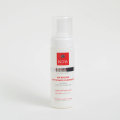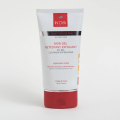Enlarged Pores, Excess Sebum & Acne: The Guide for Black, Brown, and Mixed Skin
On black, brown, or mixed skin, the trio “shine + visible pores + pimples” often recurs. It’s not just an aesthetic issue: behind this lies specific mechanisms (seborrhea, keratinization, inflammation) and a higher risk of post-acne pigmentary marks.
1) Enlarged Pores: What Exactly Are We Talking About?
A visible pore corresponds to the follicular ostium, the opening of the pilosebaceous follicle. It becomes more apparent when several mechanisms overlap. First, excess sebum: when the sebaceous glands produce too much lipid, the sebaceous flow exerts mechanical pressure that dilates the pore opening, making the skin shinier and the pores more visible.
Add to this the accumulation of keratin. Normally, dead cells slough off at the skin surface, but when keratinization is excessive, they form micro‑plugs. These plugs stretch the pores from within and contribute to an irregular skin texture.
Finally, the loss of skin elasticity worsens the phenomenon. With age, UV exposure, or oxidative stress, collagen and elastin fibers deteriorate. The pore walls lose their firmness and can no longer “contract,” which fixes the dilated appearance.
On black, brown, and mixed skin, these mechanisms are often amplified. The sebaceous glands tend to be larger and more active, promoting seborrhea. The stratum corneum, sometimes slightly thicker, retains more sebum and dead cells. Moreover, the pigmentary response to inflammation is stronger: simply touching a dilated pore or triggering a local inflammation can leave a persistent brown spot, often harder to treat than the initial issue.
2) From Sebum to Acne: The Vicious Circle
Acne doesn’t appear suddenly; it follows specific stages. It all begins with hyper‑seborrhea: the overproduction of sebum covers the skin surface with a lipid film, making the skin shiny and creating an environment conducive to skin disorders.
Then comes hyperkeratinization. Instead of naturally shedding, dead cells accumulate in the pilosebaceous follicle. Gradually, they form micro‑comedones: blackheads or whiteheads, the first acne lesions.
In this closed, oxygen‑poor environment, Cutibacterium acnes bacteria proliferate. Naturally part of the skin flora, they multiply excessively when trapped in an obstructed pore. They then release enzymes and pro‑inflammatory mediators that trigger an immune reaction.
This manifests as inflammation: the red, painful pimple. On darker skin, this stage is particularly problematic because each inflammation strongly stimulates melanocytes. The result: post‑inflammatory hyperpigmentation (PIH), leaving brown spots that often persist long after the pimple has disappeared.
Adding to these mechanisms are aggravating factors common in black and brown skin. The use of occlusive products—heavy butters, mineral oils, or thick makeup—promotes pore blockage. Haircare routines rich in oils and butters can migrate to the forehead and temples, causing what’s known as “pomade acne.” By contrast, overly aggressive cleansers destroy the skin’s hydrolipidic film and trigger a rebound effect: the skin, thinking it lacks protection, produces even more sebum. Finally, UV exposure and pollution exacerbate the oxidation of squalene (a component of sebum), intensifying inflammation and pigmentation, especially when no daily sun protection is used.
3) How to Effectively Treat Enlarged Pores, Excess Sebum, and Acne?
Addressing these issues requires a global strategy: it’s not enough to “dry out” a pimple or temporarily mattify the skin. The goal is to tackle the root cause while respecting the skin’s equilibrium. The key steps are as follows:
A. Cleanse Without Stripping
Effective cleansing is essential to remove excess sebum, sweat, pollution particles, and makeup residue. But a common pitfall is using overly harsh products. When the hydrolipidic film is destroyed, the skin reacts by producing more sebum: this is the seborrheic rebound effect.
The ideal is a gentle cleanser with non‑irritating surfactants (like Decyl Glucoside or Cocamidopropyl Betaine) combined with hydrating agents (Glycerin, Xylitol) to maintain balance. Adding purifying ingredients like salicylic acid (liposoluble BHA) or Zinc PCA helps unclog pores and regulate the skin flora right from the cleansing step.
Discover My Foam Purifying Cleanser
B. Unclog and Refine Skin Texture
Sebum and dead cells accumulate in pores. To prevent micro‑comedone formation, regular exfoliation is essential. Salicylic acid is the reference active: lipophilic, it penetrates sebum, dissolves plugs, and deeply cleans inside pores. The result: smoother skin texture, less visible pores, and fewer blackheads.
In addition, gentle fruit acids like citric acid refine the stratum corneum and stimulate cell renewal. Occasional gentle mechanical micro‑exfoliation (e.g. with hydrated silica or jojoba ester beads) can smooth the surface without causing micro‑lesions.
Discover My Gel Exfoliating Cleanser
C. Regulate Sebum Production
A lasting treatment must address seborrhea at its source. Several actives have proven efficacy:
- Niacinamide (vitamin B3), which reduces sebum production while strengthening the skin barrier—and offers a gentle brightening action, great for post‑acne spots.
- Zinc PCA, which regulates sebaceous activity and has a mild antibacterial effect.
- The complex Enantia Chlorantha Bark Extract and Oleanolic Acid, which target enzymatic activity at the root of hyper‑seborrhea (5‑α‑reductase inhibition) and help visually tighten pores.
- Tea Tree essential oil, which adds a complementary purifying effect thanks to its antibacterial and anti‑inflammatory properties—when properly dosed.
These actives reduce shine, normalize sebum secretion, and limit the formation of new comedones.
D. Calm Inflammation and Prevent Spots
Every inflamed pimple can leave a lasting pigmentary trace on darker skin. It’s therefore crucial to limit inflammation as soon as it appears. Ingredients like Bisabolol, known for its soothing properties, or Tocopherol (vitamin E), a potent antioxidant, reduce redness and oxidative stress.
Plant extracts such as hibiscus or baobab add antioxidant polyphenols and protective sugars that help soothe skin reactions and support cell regeneration. Less inflammation means less melanocyte stimulation—and fewer spots.
Discover My Anti‑Imperfection Treatment
E. Hydrate Without Clogging
It’s often thought that oily skin doesn’t need hydration—but that’s a mistake. A dehydrated skin will produce even more sebum to compensate. Hydration is therefore essential—but it must come in light, non‑comedogenic textures.
Humectants such as glycerin or propanediol retain water in the epidermis. Xylitol derivatives (xylitylglucoside, anhydroxylitol) reinforce hydration and support barrier function. To mattify immediately and reduce pore appearance, mineral powders like silica or Nylon‑12 diffuse light and provide a “blur” effect without clogging pores.
F. Protect the Skin from the Sun
On brown and dark skin, UV rays don’t necessarily cause visible sunburn—but they sustain inflammation and worsen hyperpigmentation. Daily sun protection is therefore essential, especially in case of acne or enlarged pores.
Photostable filters such as Diethylamino Hydroxybenzoyl Hexyl Benzoate (UVA), Bis‑Ethylhexyloxyphenol Methoxyphenyl Triazine (broad spectrum), or Ethylhexyl Triazone (UVB) offer effective protection. Combined with mattifying agents like tapioca starch or polymethylsilsesquioxane, they ensure a dry, pleasant finish suitable for shine‑prone skin.
5) Quick FAQ
Can pores “close”?
Not anatomically. You can reduce their appearance (less sebum, dissolved plugs, improved elasticity, optical matting).
Can SPF cause breakouts?
A well‑formulated, non‑occlusive fluid (with the filters and mattifying agents mentioned) does not cause breakouts. The issue usually comes from poor removal or textures that are too rich for your skin.
Why do my spots last so long?
On darker skin, the melanocyte response is stronger. That’s why it’s important to limit inflammation, avoid picking, and use niacinamide plus daily SPF.





